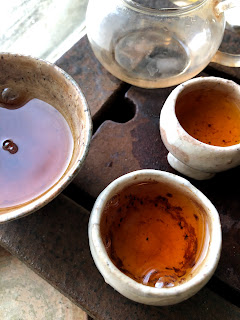Once in a while, a puerh sample will just stop me in my
tracks. Its rare these days and happens
very infrequently. Usually, it is
something that I have no preconceived perceptions of, maybe a factory,
production, or area I have never heard of before. Sometimes it’s a blind sample or a Zhongcha
that I have underestimated. The
following is once such instance.
I wasn’t planning on a serious gong fu session with this one.
I was just planning a casual drink throughout
the day and not take any notes type of puerh.
I have never heard of Rong Chang Hao before so I just assumed that this
was a transliteration error, an English is not my first language kind of mistake. I thought the writing on the sample stood for
“2006 Rongshi Qiao Mu Wang” the complimentary comparison sample that logically
paired with the 2003 (Rongshi) Mengku Shuangjiang Wild brick . Because I already have a lot of the 2006
Shuangjiang Mengku Arbour King, I was just intending to casually sample the Malaysian
storage.
After smelling the dry leaves you can be sure it is not this
tea…
Dry leaves are intensely creamy sweet layered odour. This smells of very nice Yiwu material.
The first infusion starts off with creamy dense sweetness
slight woodiness almost metallic. It arrives
in the aftertaste along with layers long cooling creamy sweetness and
woods. The mouthfeel is very nice even
in this fist infusion. It gives off a
full feeling in the mouth and deeper into the throat. It finishes slightly herbal medicine. The flavor is very woody and very creamy
sweet.
The second infusion has a very dense and layered Yiwu wood
sweetness. The mouthfeel and throat
opening are top notch. There is a creamy
almost candy like sweetness in the aftertaste after the pungent cooling opens
the throat wide.
The third infusion is very sweet with more wood bark almost
astringent bitter edge now. The
mouthfeel and throatfeel are very good and pull the long pungent very candy
sweet sweetness along. The mild
astringency pulls saliva into the throat.
The fourth infusion has a dense fruit and long wood
taste. This is very nice classic Yiwu
with a very full mouth and throat feeling.
Thick is the word. The aftertaste
is long and stretches out nicely in the mouth.
There is a medicinal soft pungent feel to it as well. Brassy almost like a Scotch.
The fifth infusion starts off very sweet and woody. The returning sweetness is really intense
here with a creamy almost malty caramel edge but also cotton candy and woody
brassy copper. The Qi is nicely warming
in the digestion and very comfort and reassuring Qi sensation. Deep toffee breath.
The sixth infusion is even sweeter woody very yummy. Woods.
A long cooling penetrating sweetness which is deep in the throat and
long on the breath. The flavours here
are delicious and straightforward, deep, and long. Its taste is very stable infusion to infusion
suggesting single mountain origin.
The seventh has a velvety woody taste to it. It has a fruitiness in its woodiness but is
more wood now. A smooth and creamy at
times wood with slight almost dry wood edges and astringency.
The eighth infusion starts vibrantly fruity plum a powdery
kind of sweetness. Candy like in the
aftertaste. Good unmistakably Yiwu
tastes here. The ninth infusion is much
the same. There is lots to enjoy here.
The tenth is coppery slight smooth wood with underlying
fruit sweetness. The eleventh has even
more of a dry woody overture turning the one full simulating mouthfeel into an
almost dry sensation. The candy like
sweet aftertaste is faint now and feel like it’s on the teeth and in the
breath.
The tea is starting to wane a bit here. I wasn’t expecting to give this puerh so much
deserving attention on this busy day. As
a result, I have no daylight left to squeeze out another infusion although this
tea could probably go for another few.
The next day I long steep it all day long probably 6 or 7
more infusions. The resulting liquor is
thick dense oily fruity syrup. This is absolutely
delicious stuff.
Overall, this is surprisingly a very nice Yiwu comparable to
other more premium factory Yiwu teas of 2006.
In my opinion the 2006 Spring harvest in Yiwu was one of the better
seasons for Yiwu puerh. This is a very
nice rounded single origin example, I enjoyed it a lot.
Just going on the production date and my experience above
and knowing nothing about Rong Chang Hao I would say a 357g bing could sell for
$350-$500.
Thanks KL Wong for being the Teapal he is and sending
it. This tea really made my day. I had never heard of it before and it really
stopped me in my tracks today and gave me a rewarding session.
Check out KL Wongs impression of this peruh here. I wonder if he will sell some of this stuff?
Peace
Edit May 20/2019: I picked up 3 of these cakes but was warned that the edges of the cake come off a little too bitter because of the pressing. The above sample was likely from the centre because when I got these cakes the edges were a bit more intense in an already strong cake. Overall, the Qi and throat-feel is impressive but can come off a touch too harsh at times. Super enjoyable sheng for those who like a bit of kick and then relax unconventional in a Yiwu. Peace


























